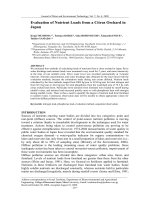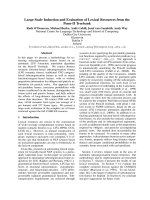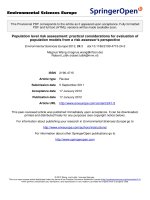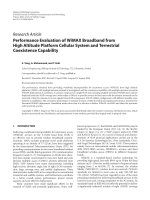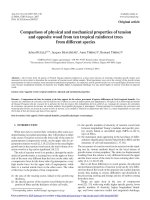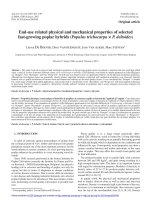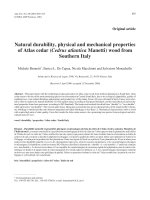Evaluation of physical and textural properties of cookies prepared from pearl millet flour
Bạn đang xem bản rút gọn của tài liệu. Xem và tải ngay bản đầy đủ của tài liệu tại đây (218.9 KB, 10 trang )
Int.J.Curr.Microbiol.App.Sci (2017) 6(4): 692-701
International Journal of Current Microbiology and Applied Sciences
ISSN: 2319-7706 Volume 6 Number 4 (2017) pp. 692-701
Journal homepage:
Original Research Article
/>
Evaluation of Physical and Textural Properties of Cookies
Prepared from Pearl Millet Flour
A.A. Kulthe*, S.S. Thorat and S.B. Lande
Department of Food Science and Technology, MPKV, Rahuri – 413 722, (M.S.) India
*Corresponding author
ABSTRACT
Keywords
Cookies; Pearl
millet flour; Spread
factor; Spread ratio;
Texture analysis.
Article Info
Accepted:
06 March 2017
Available Online:
10 April 2017
Cookies were prepared by substituting wheat maida with pearl millet flour (PMF)
from three cultivars (viz. Shanti, Dhanshakti and Pioneer 84M64) at 0, 10, 20, 30,
40 and 50% levels using traditional creamery method. Incorporation of PMF in
cookies decreased diameter, spread ratio and spread factor of cookies whereas the
thickness increased slightly. The colour values L* and b* decreased while a*
increased with the addition of PMF to the cookies. The hardness, breaking
strength and cutting strength of cookies were increased with the incorporation of
PMF in cookies. Thus incorporation of PMF (var. Dhanshakti) in formulation of
cookies was found to be superior to Shanti and Pioneer 86M64, based on physical
and textural quality of cookies.
Introduction
is one reason for its poor acceptability by
rice/wheat eaters.
Pearl millet (Pennisetum glaucum L) is the
fourth most important cereal of India after
rice, wheat and sorghum. It provides cheap
staple food with comparatively more nutrients
to millions of poor people, cattle and poultry
(Khairwal et al., 1997).
It is recognized
as being the most widely grown of all the
millet types. It is the basic staple food in the
poorest countries and used by the poorest
people. For human consumption it can be
used in a variety of ways including both
leavened and unleavened breads, in porridges,
and can also be boiled or steamed. Due to the
presence of the fibrous seed coat, the flour of
pearl millet is coarse and has a grey to yellow
colour which imparts bitter taste and the
products prepared from whole flour have low
consumer appeal (Olatungi et al., 1982). This
The Indian bakery industry has important
place in the industrial map of the country.
Bakery products are an item of mass
consumption in view of its low price and high
nutritive value. Consumers demand healthier
bakery products and some of the popular
trends in the market are the introduction of
low/light, functional, natural and organic
products (Jamuna and Suresha, 2012). In
addition to healthier products, consumers are
also purchasing products that satisfy their
taste buds. The taste enjoyment factor is vital
in the market place, as the large range in
bakery products available provides a wide
range of consumer choice. Consumers
692
Int.J.Curr.Microbiol.App.Sci (2017) 6(4): 692-701
increasingly seek premium and exotic
products to satisfy their desire to indulge.
Cakes, pastries, biscuits and cookies are the
typical indulgent products within the bakery
sector. Cookies are ready to eat, convenient,
inexpensive and one of the most popular and
widely consumed processed food products in
India (Shukla and Shipla, 2000).
maida 100, sugar 50, vanaspati 50,
ammonium
bicarbonate
0.5,
sodium
bicarbonate 0.5, and required amount of
water. Cookies were prepared by substituting
wheat maida with 0, 10, 20, 30, 40 and 50%
(w/w) PMF. The cookies were evaluated for
physical and textural properties.
Physical parameters
Cookies are now in common use in India and
are preferred and loved by almost every
individual irrespective of class and age.
Bakery industry has a very important role to
play in economic development of the country
and also in building the health of people. The
nutritional significance of the bakery products
is well recognized. Attempts are being made
to enrich the products with high quality nonwheat flours like cookies which are ready to
eat, convenient, inexpensive and one of the
most popular and widely consumed processed
food products in India.
Weight, diameter, thickness, spread ratio and
% spread factor of cookies were estimated as
per AACC (1976) methods.
Colour values
The colour scanning machine (Model: Colour
Flex EZ) was used for the measurement of
colour of cookies. The colour was measured
by using CIELAB scale at 10° observer at
D65 illuminant. The cookies sample was
placed in the sample cup and the reading in
terms of L*, a* and b* were measured. The
deviation of the colour of the sample to
standard was observed and recorded in the
computer interface.
The present work visualizes the exploitation
of pearl millet in cookies and evaluating its
effect on the physical and textural properties
of cookies.
Textural characteristics of cookies
Materials and Methods
Textural characteristics of cookies such as
hardness, breaking strength and cutting
strength of cookies were measured using
Instron Universal Texturometer (Shimadzu
AG-Xplus). Each cookie was placed on the
loading cell and compressed as per the
standard procedures given by Singh et al.,
(1993).
Materials
Three cultivars of pearl millet viz., Shanti
(RHRBH 9808), Dhanshakti (ICTP 8203 Fe
10-2) and Pioneer 86M64 were procured from
Department of Plant Breeding, College of
Agriculture, Dhule, Mahatma Phule Krishi
Vidyapeeth, Rahuri. The raw materials such
as maida, sugar, vanaspati, sodium
bicarbonate, ammonium bicarbonate, etc.
were purchased from local market of Rahuri.
Statistical analysis
The data obtained was analyzed statistically
to determine statistical significance of
treatments. Completely Randomized Design
(CRD) was used to test the significance of
results (Panse and Sukhatme, 1967). The
analysis of variance revealed at significance
of p<0.05 level, S.E. and C.D. at 5 % level
was mentioned wherever required.
Preparation of cookies
Cookies were prepared using the traditional
creamery method described by Whitley
(1970). The ingredients included (g) wheat
693
Int.J.Curr.Microbiol.App.Sci (2017) 6(4): 692-701
be optimized. The previous studies (MaacheRezzoug et al., 1998) showed positive
correlation between sugar content and
diameter of biscuits; the greater the quantity
of sugar, the greater increase in the biscuit
length, with considerable decrease in
thickness when sogar content was increased.
As the level of PMF increased there was
increase in the more water absorbing fibre
content compared to sugar content. Increase
in fibre content retarded the spreading of
cookies thus reducing the diameter with
subsequent increase in thickness of cookies
(Agrahar-Murugkar et al., 2014).
Results and Discussion
The cookies were prepared by substituting
maida with PMF of each variety viz., Shanti,
Dhanshakti and Pioneer 86M64 at levels of
10, 20, 30, 40 and 50 per cent. The cookies
were evaluated for their physical and textural
characteristics and results are presented
below.
Physical properties
incorporated cookies
of
pearl
millet
The data regarding physical properties such as
weight, diameter, thickness, spread ratio, and
spread factor of cookies is presented in table
1. It was observed that the weight of cookies
decreased gradually from 9.97 to 9.54 g with
increasing proportion of PMF. Also there was
simultaneous decrease in diameter from 49.40
to 44.66 mm. No trend was observed for
thickness of cookies because the baking was
not performed under strict conditions of
temperature and humidity.
Among PMF varieties (Table 1), Dhanshakti
PMF based cookies recorded highest spread
ratio (4.32) and spread factor (116.76 %) as
compared to control and other samples.
Reduced spread ratio and spread factor of
cookies were attributed to the fact that
composite flours of wheat and PMF
apparently form aggregates with increased
number of hydrophilic sites available for
competing, for the limited free water in dough
(McWatters, 1978). Rapid partitioning of free
water of these hydrophilic sites occurs during
dough mixing and increases dough viscosity,
thereby limiting the cookie spread (AgraharMurugkar et al., 2014). Also gluten
influenced the diameter and spread onset time
which is again dependent on the amount free
water available to the non-gluten constituents
(Bram et al., 2008).
The spread ratio of cookies firstly increased
from 3.71 to 5.05 and then decreased
significantly from 5.05 to 3.44 with
increasing level of PMF. The spread factor of
cookies too showed similar trend. The spread
factor of control sample was considered as
standard (100 %). In comparison to control
sample, there was initial increase in spread
factor of cookies with 10 % PMF. This initial
increase in spread ratio might be due to the
combined effect of sugar and fibres in the
dough. In cookies containing 10 % PMF, the
high sugar and low fibre content resulted in
increased diameter and reduced thickness of
cookies during baking. Among the PMF
based samples, the spread factor significantly
decreased from 136.50 to 92.97 % with
increased addition of PMF. But since the
spread factor of cookies with PMF up to 40 %
was comparable as that of control sample, the
substitution level of 40 % was considered to
Colour of pearl millet based cookies
Colour appears to be the important element
for initial acceptability of baked product by
consumers. Moreover, as colour development
occurs largely during the later stages of
baking (Wade, 1988), it can be used to judge
completion of the baking process. Cookies
incorporated with PMF were evaluated for
their colour values in terms of L*, a*, b*, C*
and H*.
694
Int.J.Curr.Microbiol.App.Sci (2017) 6(4): 692-701
The level of substitution as well as variety of
pearl millet both affected the colour values
i.e. L*, a* and b* of cookies (Table 2). The
values L* and b* decreased from 74.347 to
55.351 and from 21.143 to 16.314,
respectively where as a* increased from 1.220
to 3.633 with increasing level of PMF.
Pearl millet has polyphenol oxidase and
peroxidase activities (Prabha and Patwardhan,
1982; Saby John et al., 2003) and they are
rich in polyphenols, which are substrates for
these enzymes (Ajila et al., 2007; Saby John
et al., 2003). Therefore, due to the enzymatic
browning, brightness and yellowness of the
cookies may be decreased (Ajila et al., 2008).
Also, as PMF has greenish colour,
incorporation of PMF with wheat flour also
decreased the brightness of the cookies.
The colour values of control samples; L*, a*,
b*, C* and H* were observed as 74.347, 1.22,
21.143, 21.178 and 86.663, respectively. The
colour values (L*, a* and b*) of cookies with
different PMF varieties viz., Shanti (62.171,
2.865, 18.351, 18.609 and 81.017),
Dhanshakti (63.113, 2.920, 18.673, 18.927
and 80.918) and Pioneer 86M64 (61.190,
2.933, 18.162, 18.278 and 80.239) were
recorded and among the different varieties,
the Dhanshakti PMF incorporated cookies
showed good colour values.
Textural
characteristics
incorporated cookies
of
PMF
Texture is a very important characteristic
which makes a significant contribution to the
overall acceptance of food products. It is one
of the three main acceptability factors used by
consumers to evaluate food, the other two
being appearance and flavor (Bourne, 1990).
The results with respect to textural
characteristics of cookies like hardness,
breaking strength, cutting strength and energy
are presented in table 3.
Colour development of baked products is
caused by Maillard reactions between sugars
and proteins (Lingnert, 1990). The Maillard
reaction is a non-enzymatic reaction which
causes the formation of melanoidins. Others
factors that might contribute to the colour of
final products were ingredients’ composition,
time of baking (Cronin and Preis, 2000). The
humidity in the oven and atmosphere in the
early stages of baking also affected the
development of final colour (Wade, 1988).
Pearl millet cookies were dark and fragile as
compared to control samples prepared from
maida alone. The darkness of cookies
increased with the increase in the proportion
of PMF from 10 to 50 per cent. Significant
difference (p<0.05) was found in the color
parameters for cookies obtained from all
treatments. The L* value of all PMF based
cookies were lower than control sample
indicating darker color due to the nature of
ingredients. The positive a* value represents
redness of PMF cookies. A positive b* value
is a measure of the yellowness and the low b*
values indicated darkness of cookies prepared
with incorporation of PMF.
The average peak force is the measure of
cookies hardness. It was observed that there
was significant increase in hardness of
cookies from 3.76 to 15.97 N with increasing
levels of PMF in cookies. The increased
hardness may be attributed to dilution of
wheat proteins with pearl millet proteins. The
interaction of pearl millet proteins with wheat
proteins made cookies compact, thus
increasing the hardness.
Hoseney and Rogers (1994) reported that
hardness of cookies is caused by the
interaction of protein and starch by hydrogen
bonding. Similar results were observed by
Singh et al., (1996) who reported increased
hardness in biscuits with increasing levels of
DSF up to 50 per cent.
695
Int.J.Curr.Microbiol.App.Sci (2017) 6(4): 692-701
Table.1 Physical parameters of cookies affected by pearl millet variety and treatments
Weight (g)
Diameter (mm)
Thickness (mm)
Spread Ratio
Spread Factor (%)
Treatments
V1
V2
V3
Mean
V1
V2
V3
Mean
V1
V2
V3
Mean
V1
V2
V3
Mean
V1
V2
V3
Mean
T0
9.97
9.97
9.97
9.97
49.40
49.40
49.40
49.40
13.33
13.33
13.33
13.33
3.71
3.71
3.71
3.71
100.00
100.00
100.00
100.00
T1
9.90
9.94
9.85
9.90
49.67
50.00
49.43
49.70
10.00
9.40
10.17
9.86
4.97
5.32
4.86
5.05
134.05
143.57
131.24
136.50
T2
9.83
9.86
9.80
9.83
48.17
48.53
47.37
48.02
10.33
10.20
10.97
10.50
4.66
4.95
4.32
4.59
125.81
133.67
116.58
124.11
T3
9.72
9.78
9.68
9.73
47.07
47.57
46.27
46.97
11.80
10.60
12.00
11.47
3.99
4.49
3.86
4.13
107.66
121.12
104.06
111.52
T4
9.59
9.71
9.53
9.61
45.93
46.37
45.73
46.01
12.67
11.37
12.77
12.27
3.63
4.08
3.58
3.78
97.88
110.10
96.69
102.07
T5
9.52
9.64
9.47
9.54
44.60
45.30
44.07
44.66
13.00
13.00
13.10
13.03
3.43
3.48
3.36
3.44
92.60
94.05
90.79
92.97
Mean
9.76
9.82
9.72
47.47
47.86
47.04
11.86
11.32
12.06
4.07
4.32
3.96
109.77
116.76
107.06
SEm±
CD at 5%
SEm±
CD at 5%
SEm±
CD at 5%
SEm±
CD at 5%
SEm±
CD at 5%
Treatment (T)
0.033
0.096
0.028
0.080
0.028
0.081
0.092
0.264
3.088
8.892
Variety (V)
0.024
0.068
0.020
0.057
0.020
0.058
0.065
0.187
2.183
6.287
TxV
0.058
0.170
0.048
0.141
0.049
0.145
0.159
0.469
5.348
NS
Each value is the average of three determinations
V1- Shanti, V2- Dhanshakti, V3- Pioneer 86M64
696
Int.J.Curr.Microbiol.App.Sci (2017) 6(4): 692-701
Table.2 Influence of treatments and pearl millet variety on colour values of cookies
Treatme
nts
T0
T1
T2
T3
T4
T5
Mean
L*
a*
b*
C*
H*
V1
V2
V3
Mean
V1
V2
V3
Mean
V1
V2
V3
Mean
V1
V2
V3
Mean
V1
V2
V3
Mean
74.3
47
65.6
60
60.4
17
58.9
52
58.0
84
55.5
66
62.1
71
74.3
47
66.8
66
62.2
71
60.6
95
58.7
10
55.7
87
63.1
13
74.3
47
62.9
37
59.8
00
58.4
66
56.8
89
54.7
00
61.1
90
74.3
47
65.1
54
60.8
29
59.3
71
57.8
94
55.3
51
1.2
20
2.0
33
2.5
76
3.7
12
3.9
57
3.6
94
2.8
65
1.2
20
2.5
97
3.4
33
3.5
03
3.3
93
3.3
73
2.9
20
1.2
20
2.6
09
2.6
81
3.4
38
3.8
17
3.8
30
2.9
33
1.2
20
2.4
13
2.8
97
3.5
50
3.7
22
3.6
33
21.1
43
18.7
60
17.3
59
17.7
40
18.5
89
16.5
17
18.3
51
21.1
43
20.3
55
18.7
48
17.7
32
17.7
08
16.3
52
18.6
73
21.1
43
18.6
47
17.7
83
17.6
73
17.6
52
16.0
72
18.1
62
21.1
43
19.2
54
17.9
63
17.7
15
17.9
83
16.3
14
21.1
78
18.8
70
17.5
49
18.1
24
19.0
05
16.9
25
18.6
09
21.1
78
20.5
20
19.0
60
18.0
75
18.0
30
16.6
96
18.9
27
21.1
78
18.8
29
18.1
60
16.9
20
18.0
60
16.5
22
18.2
78
21.1
78
19.4
06
18.2
56
17.7
06
18.3
65
16.7
14
86.6
63
83.7
81
81.5
26
78.1
50
77.9
52
77.3
62
81.0
17
86.6
63
82.6
96
79.5
91
78.7
93
79.1
21
78.3
13
80.9
18
86.6
63
82.0
02
78.2
74
80.1
64
77.7
67
76.5
65
80.2
39
86.6
63
82.9
37
79.7
97
79.0
36
78.3
91
77.5
24
SEm±
CD at 5%
SEm±
CD at 5%
SEm±
CD at 5%
SEm±
CD at 5%
SEm±
CD at 5%
Treatment
(T)
0.741
3.135
0.010
0.028
0.716
2.061
0.676
1.946
1.286
3.704
Variety
(V)
0.524
1.509
0.007
0.020
0.506
1.516
0.478
1.431
0.909
2.725
TxV
1.284
NS
0.017
0.048
1.240
NS
1.171
NS
2.228
NS
Each value is the average of three determinations
V1- Shanti, V2- Dhanshakti, V3- Pioneer 86M64
697
Int.J.Curr.Microbiol.App.Sci (2017) 6(4): 692-701
Table.3 Effect of treatments and pearl millet variety on textural characteristics of cookies
Hardness (N)
Breaking Strength (N)
Cutting Strength (N)
Treatments
V1
V2
V3
Mean
V1
V2
V3
Mean
V1
V2
V3
Mean
T0
3.76
3.76
3.76
3.76
29.78
29.78
29.78
29.78
30.39
30.39
30.39
30.39
T1
6.61
5.18
6.95
6.25
34.13
30.39
35.33
33.28
35.47
31.22
37.35
34.68
T2
8.81
7.67
8.93
8.47
37.48
34.16
37.86
36.50
38.56
35.68
39.49
37.91
T3
11.57
9.26
12.69
11.17
40.13
35.68
40.33
38.71
40.50
37.48
41.05
39.68
T4
13.46
11.58
14.82
13.29
41.57
38.97
41.67
40.74
42.71
40.16
43.75
42.21
T5
16.67
13.86
17.39
15.97
44.63
39.48
44.89
43.00
44.30
41.64
45.22
43.72
Mean
10.15
8.55
10.76
37.95
34.74
38.31
38.66
36.09
39.54
SEm±
CD at 5%
SEm±
CD at 5%
SEm±
CD at 5%
Treatment (T)
0.016
0.046
0.017
0.048
1.361
3.919
Variety (V)
0.011
0.033
0.012
0.034
0.962
NS
TxV
0.028
0.080
0.029
0.083
2.357
NS
Each value is the average of three determinations
V1- Shanti, V2- Dhanshakti, V3- Pioneer 86M64
698
Int.J.Curr.Microbiol.App.Sci (2017) 6(4): 692-701
Gandhi et al., (2001) also reported increased
hardness of cookies prepared by replacing
wheat flour up to 40 % level with DSF.
Krishnan et al., (2011) also reported increase
in the hardness of biscuits prepared from
finger millet seed coat based composite flour.
Among PMF varieties, Pioneer 86M64
recorded the highest increase in hardness
(10.76 N), breaking strength (38.31 N),
cutting strength (39.54 N) and energy (0.037
J) followed by cookie with Shanti PMF
recording intermediate values (10.15 N, 37.95
N, 38.66 N and 0.036 J respectively), while
Dhanshakti showed lowest increase in
textural characteristics (8.55 N, 34.74 N,
36.09 N and 0.030 J, respectively) of cookies.
This may be attributed to the difference in the
chemical composition of PMF.
The breaking strength is also one of the
criteria to measure the cookies hardness. The
results indicated that the breaking strength of
cookies significantly increased from 29.78 to
43.00 N with increasing levels of PMF in
cookies. Sugar may recrystallise during
cooling or product storage as water is
removed during baking, creating a
supersaturated sucrose solution in the cookies.
Earlier research showed that sugar
crystallization and formation of a glassy solid
after baking would influence hardness of
biscuit (Gaines et al., 1992; Slade and Levine,
1994; Slade et al., 1993) Recently, Sudha et
al., (2007) reported a decrease in diameter
and increase in breaking strength of biscuits
upon addition of cereal bran and decrease in
thickness upon addition of barley bran.
In a previous study of semi-sweet biscuit
production with different varieties, it was
observed that, for some varieties, a weakening
in dough strength reduced biscuit hardness,
but that for other varieties the hardness of
biscuits was unaffected by changes in dough
strength (Oliver et al., 1995). The results are
agreement with the earlier report.
In conclusion the results of this study indicate
that, the physical and textural characteristics
of cookies were affected by different levels
and varieties of PMF. Incorporation of PMF
in cookies spread ratio and spread factor of
cookies. Cookies with PMF were dark in
colour as compared to control sample
prepared from maida alone. Good quality
cookies can be prepared by substituting maida
with pearl millet flour up to 40%. Dhanshakti
variety found to be better for cookie making
in comparison to Shanti and Pioneer 86M64
with respect to physical and textural
properties of cookies.
In the cutting test, the probe cut the cookie
right through and the resulting graph had a
cuspidate (elephant tusk) profile, resulting
from the progressive increasing force during
cutting. The maximum peak was registered at
about 2 mm from the start of cutting, after
that there was drastic force loss. The residual
force registered was due to the friction of
blade passing through the cookies. The
cutting strength of cookies showed similar
trend for hardness and breaking strength of
cookies. The cutting strength of cookies
increased from 30.39 to 43.72 N with
increasing levels of PMF in cookies. The
increase in cutting strength of cookies may be
due to relatively higher water content in PMF
incorporated doughs. It is reported that
doughs having higher water content produce
an extensive gluten structure and result in
harder cookies (Gaines, 1990; Labuschagne et
al., 1996; Smith, 1972).
References
AACC. 1976. American Association of Cereal
Chemists, 7th Edn.
AOAC. 1995. Official Methods of Analysis
15th Edn., Association of Official
Analytical Chemists, Washington DC.
AOAC. 1990. Official Methods of Analysis
15th Edn., Association of Official
699
Int.J.Curr.Microbiol.App.Sci (2017) 6(4): 692-701
Analytical Chemists, Washington D.C.
AOAC. 2005. Official Methods of Analysis
18th Edn., Association of Official
Analytical Chemists, Washington D.C.
Agrahar-Murugkar,
D.,
Gulati,
P.,
Kotwaliwale, N. and Gupta, C. 2014.
Evaluation of nutritional, textural and
particle size characteristics of dough
and biscuits made from composite
flours containing sprouted and malted
ingredients. J. Food Sci. Technol., DOI:
10.1007/s13197-014-1597-y
Ajila, C.M., Bhat, S.G. and Prasada Rao,
U.J.S. 2007. Valuable components of
raw and ripe peels from two Indian
mango varieties. Food Chem., 102:
1006-1011.
Ajila, C.M., Leelavathi, K. and Prasada Rao,
U.J.S. 2008. Improvement of dietary
fiber content and antioxidant properties
in soft dough biscuits with the
incorporation of mango peel powder. J.
Cereal Sci., 48: 319-326.
Bram, P., Edith, W., Hans, G., Kristof, B. and
Jan, A. D. 2008. The role of gluten in a
sugar-snap cookie system: A model
approach based on gluten-starch blends.
J. Cereal Sci., 48: 863-869.
Cronin, K. and Preis, C. 2000. A statistical
analysis of biscuit physical properties as
affected by baking. J. Food Engg.,
46(4): 217-225.
Florence, S.P., Asna, U., Asha, M.R. and
Jyotsna, R. 2014. Sensory, physical and
nutritional qualities of cookies prepared
from
pearl
millet
(Pennisetum
typhoideum). J. Food Process. Technol.,
5(10): 377, DOI: 10.4172/21577110.1000377.
Gaines, C.S. 1990. Influence of chemical and
physical modification of soft wheat
protein on sugar-snap cookie dough
consistency, cookie size, and hardness.
Cereal Chem. 67(1): 73-77.
Gaines, C.S., Kassuba, A. and Finney, P.L.
1992. Insrtumental measurement of
cookie hardness. I. Assesment of
methods. Cereal Chem., 62(2): 115-119.
Gandhi, A.P., Kotwaliwale, N., Kawalkar, J.,
Shrivastava, D.C., Parihar, V.S. and
Raghunadh, P. 2001. Effect of
incorporation of defatted soyflour on
the quality of sweet biscuits. Ad-hock
Project on Alternate Solvent, Soybean
Processing and Utilization Centre,
Central Institute of Agricultural
Engineering, Bhopal - 462038, India.
Jamuna, K.V. and Suresha, S.V. 2012. An
overvirw of the bakery industry in
India. Food Marketing Technol., 3(9):
40-42.
Krishnan, R., Dharmaraj, U., Manohar, R.S.
and Malleshi, N.G. 2011. Quality
characteristics of biscuits prepared from
finger millet seed coat based composite
flour. Food Chem., 129: 499-506.
Labuschagne, M.T., Brooks Coetzee, M.C.
and van Deventer. 1996. Biscuit-making
quality prediction using heritability
estimates and correlations. J. Sci. Food
Agric., 70: 25-28.
Lingnert, H. 1990. Development of the
Maillard
reaction
during
food
processing. In P. A. Finot (Ed.) Maillard
reaction in food processing, Human
Nutri. Physiol., (pp: 171). Basel:
Birkhauser Verlag.
Maache-Rezzoug, Z., Bouvier, J.M., Alla, K.
and Patras, C. 1998. Effect of principal
ingredients on rheological behaviour of
biscuit dough and on quality of biscuits.
J. Food Engg., 35: 23-42.
McWatters, K.H. 1978. Cookie baking
properties of defatted peanut, soybean
and field pea flour. Cereal Chem.,
55(6): 853-863.
Mepba, H.D., Eboh, L. and Nwaojigwa, S.U.
2007. Chemical composition, functional
and baking properties of wheat-plantain
composite flours. Afr. J. Food Agric.
Nutr. Dev., 7(1): 1-22.
700
Int.J.Curr.Microbiol.App.Sci (2017) 6(4): 692-701
Olatungi, O., Akinrele, I.A., Erwards, C.C.,
and Loleoso, O.A. 1982. Sorghum and
millets processing and uses in Nigeria.
Cereal Foods World, 27: 277-280
Oliver, G., Thacker, D. and Wheeler, R.J.
1995. Semi-sweet biscuits. 1: The
influence of sodium metabisulphite on
dough
rheology
and
baking
performance. J. Sci. Food Agric., 69:
141-150.
Oluwamukomi, M.O., Oliwalana, I.B. and
Akinbowale, O.F. 2011. Physicochemical and sensory properties of
wheat-cassava
composite
biscuit
enriched with soy flour. Afr. J. Food
Sci., 5(2): 50-56.
Panse, V.S. and Sukhatme, P.V. 1967.
Statistical Methods for Agricultural
Workers. Indian Council of Agri. Res.,
New Delhi. pp: 70-72.
Prabha, T.N. and Patwardhan, M.V. 1982.
Purification
and
properties
of
polyphenol oxidase of mango peel. J.
Biosci., 4: 69-78.
Shukla, F.C. and Shilpa, M. 2000. Bakery
industry in India. Present quality control
and future scenario-A review. Bev.
Food World, 27: 11-15.
Singh, B., Bajaj, M., Kaur, A., Sharma, S. and
Sidhu, J. 1993. Studies on development
of high protein biscuits from composite
flours. Plant Foods Human Nutr., 43(2):
181-189.
Singh, R., Singh, G. and Chauhan, G.S. 1996.
Effect of incorporation of defatted soy
flour on quality of biscuits. J. Food Sci.
Technol., 33(4): 355-357.
Slade, L. and Levine, H. 1994. Structure–
function relationship of cookie and
cracker ingredients. In H. Faridi (Ed.).
The science of cookie and cracker
production (pp: 23–141). New York:
Chapman and Hall.
Slade, L., Levine, H., Ievolella, J. and Wang,
M. 1993. The glassy state phenomenon
in applications for the food industry.
Application of the food polymer science
approach
to
structure–function
relationships of sucrose in cookie and
cracker systems. J. Sci. Food Agric., 63:
133-176.
Smith, W.H. 1972. Hard semi-sweet biscuits.
In: Biscuits, Crackers and Cookies:
Technology,
Production
and
Management, vol. 1. Applied Science
publishers Ltd., London, pp: 466-473.
Snedecor, C.W. and Cochran, W.G. 1967.
Statistical Methods, 6th Edn., Oxford
and IBH Publishing Co., New Delhi.
Sudha, M.L., Vetrimani, R. and Leelavathi,
K. 2007. Influence of fibre from
different cereals on the rheological
characteristics of wheat flour dough and
on biscuit quality. Food Chem., 100:
1365-1370.
Wade, P. 1988. Biscuit, Cookies and
Crackers: The Principles of the Craft.
(1st Edn.) London, UK: Elsevier
Applied Sciences.
How to cite this article:
Kulthe, A.A., S.S. Thorat and Lande, S.B. 2017. Evaluation of Physical and Textural Properties
of Cookies Prepared from Pearl Millet Flour. Int.J.Curr.Microbiol.App.Sci. 6(4): 692-701.
doi: />
701
